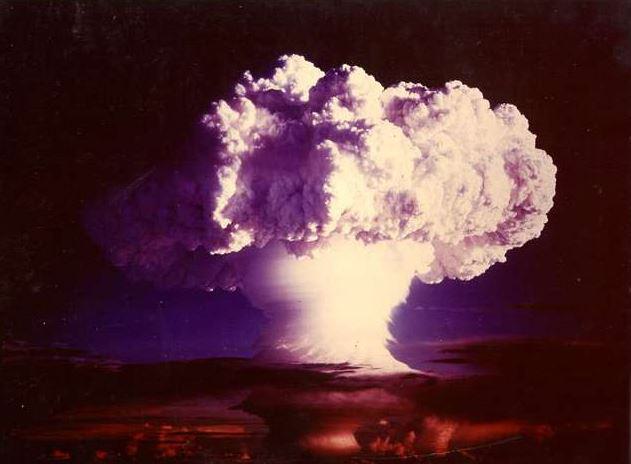“Dr. Strangelove: Mr. President, it is not only possible, it is essential. That is the whole idea of this machine, you know. Deterrence is the art of producing in the mind of the enemy... the fear to attack. And so, because of the automated and irrevocable decision-making process which rules out human meddling, the doomsday machine is terrifying. It’s simple to understand. And completely credible, and convincing.
General Buck Turgidson: Gee, I wish we had one of them doomsday machines, Stainsy.”
— from Stanley Kulbrick’s “Dr. Strangelove or: How I Learned to Stop Worrying and Love the Bomb”
Something is rotten in America. A stench hangs in the air with the flies, though its exact source remains a mystery.
The odor seems ever-present and pervasive, defying the laws of space and time. This rot, this backsliding, this anxiety, this amnesia – it all smells like a putrid past returned as the whiff of a too-near carrion future, and we’re almost used to it by now. Fear, Honor, and Interest might as well be called time travelers. These wisps, these ghosts of past and future, swell again in men’s nostrils, prodding yet another generation worldwide towards the havoc and mayhem of war.
Yet, have hope! Do not despair! Doomsday may yet be held off by the threat of doomsday!
The good news is that the best and brightest of America’s military industrial complex have unveiled their latest development in the art of war: a better bomb, more powerful and precise than before.
“On Friday, the Department of Defense announced a new effort to field an updated and even more powerful variant of the B61 series nuclear bomb currently in service,” a recent report reveals. “This new weapon, dubbed the B61-13, is expected to deliver around 360 kilotons of destructive power – 21 times the yield of the atomic bomb dropped on Hiroshima in 1945; it will be among the most powerful nukes in the U.S. arsenal.”
The report continues:
“[B]y combining a relatively high 360-kiloton yield with the same precision guidance kits devised for the B61-12, these new bombs will offer a unique combination of pinpoint accuracy and significant destructive power, which the Federation of American Scientists posits could make for an effective means of targeting even hardened subterranean structures.”
Bravo! Encore! I feel safer already.
The beautiful thing is that a better bomb isn’t just a practical reassurance when developing effective military deterrence. A better bomb can also serve as an apt catalyst for many other less direct concerns, foremost the reinvigoration of national spirit.
We face a truly unstable moment in our nation’s history – a smelly convergence of technological, scientific, political, cultural, generational, and spiritual upheaval – yet the age also remains marked by a lowdown weariness and loss of faith in major American institutions, ourselves, and even God.
That’s where hope in a better bomb comes in. Given our national moment of tumult and languor, I say we keep making the bombs better until morale improves.
Yes, your food, your fuel, and your housing is more expensive than ever before, but now that we have a better bomb with an inflated payload, everyday inflation seems much easier to bear. Who cares about making ends meet when we potentially face the end?
Yes, your political leaders may seem old, decrepit, and long lost to any decency, but now that we have a better, younger bomb in tiptop shipshape, maybe its destructive deterrence will spur a return to decency and respect. Author Robert Heinlein had it right in saying: “An armed society is a polite society. Manners are good when one may have to back up his acts with his life.”
Yes, we may have lost our fear of the Lord, but at least we now fear the wrath of a better bomb. God’s judgment is now a mushroom cloud – 21 Hiroshimas! Bolstered by the wonder and awe of this potential manmade doomsday, there is nothing the American people can’t do.
A better bomb is terrifying. It’s simple to understand, completely credible, and convincing. If a better bomb can’t save us, nothing can.
Yet, despite hope in a better bomb, that indescribable stench remains.
What in the world is that smell?
“A good deal has been written about Hiroshima,” writes Colonel Roscoe C. Wilson, one of the first Americans to visit the Japanese city after its doom, “but no-one can describe adequately the smell — and the flies.”
He continues:
“The former was noticeable from a distance of several miles: first a faint taint which at certain points in the city became almost overpowering. Even the Japanese, who seem not to notice their nauseating “honey carts,” [very old slang for carts that carry human manure] had their noses bound up while they probed the ruins. And the blue-bottle flies swarmed in clouds. To open a car window was to fill the car with flies. And we climbed through the ruins in individual swarms.
I tramped through Hiroshima unaccompanied, except for a photographer. The able-bodied people paused to watch us, but never displayed any hostility. I went where I wished, except that I was dissuaded from climbing a hill in the southeast part of the city. I was told that was the abode of Yama — God.”
The views and opinions expressed here are those of the author and do not necessarily reflect the policy or position of 1819 News. To comment, please send an email with your name and contact information to Commentary@1819news.com.
Don’t miss out! Subscribe to our newsletter and get our top stories every weekday morning.










